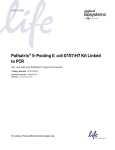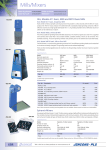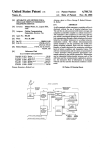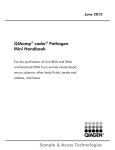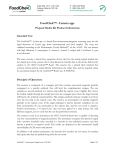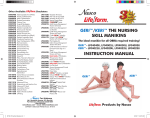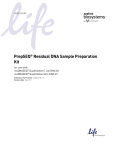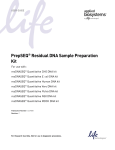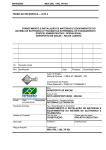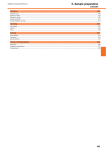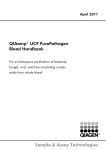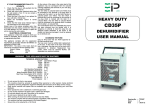Download Pathatrix® Listeria spp. Kit (Individual Samples) Linked to PCR and
Transcript
USER GUIDE Pathatrix® Listeria spp. Kit (Individual Samples) Linked to PCR or ELISA For use with the Pathatrix® Auto Instrument Catalog Number APL50 Publication Number MAN0007136 Revision 4 September 2012 For testing of Food and Environmental samples only. The information in this guide is subject to change without notice. DISCLAIMER LIFE TECHNOLOGIES CORPORATION AND/OR ITS AFFILIATE(S) DISCLAIM ALL WARRANTIES WITH RESPECT TO THIS DOCUMENT, EXPRESSED OR IMPLIED, INCLUDING BUT NOT LIMITED TO THOSE OF MERCHANTABILITY, FITNESS FOR A PARTICULAR PURPOSE, OR NON-INFRINGEMENT. TO THE EXTENT ALLOWED BY LAW, IN NO EVENT SHALL LIFE TECHNOLOGIES AND/OR ITS AFFILIATE(S) BE LIABLE, WHETHER IN CONTRACT, TORT, WARRANTY, OR UNDER ANY STATUTE OR ON ANY OTHER BASIS FOR SPECIAL, INCIDENTAL, INDIRECT, PUNITIVE, MULTIPLE OR CONSEQUENTIAL DAMAGES IN CONNECTION WITH OR ARISING FROM THIS DOCUMENT, INCLUDING BUT NOT LIMITED TO THE USE THEREOF. Limited Use Label License: Environmental testing, quality control/quality assurance testing, food and agricultural testing The purchase of this product conveys to the purchaser the limited, non-transferable right to use the purchased amount of the product (a) to perform internal research for the sole benefit of the purchaser; and (b) for environmental testing, quality control/quality assurance testing, food and agricultural testing, including reporting results of purchaser's activities in environmental testing, quality control/quality assurance testing, food and agricultural testing for a fee or other commercial consideration. No other right is hereby granted expressly, by implication, or by estoppel. This product is for environmental testing, quality control/quality assurance testing, food and agricultural testing and research purposes only. The purchase of this product does not grant the purchaser any additional rights, including (without limitation) the right to transfer or resell the product in any form or the right to use the product as a therapeutic agent or diagnostics test component, or to use the product to perform other tests on a contract or fee per test basis for or on behalf of third parties. For information on obtaining additional rights, please contact [email protected]. TRADEMARKS The trademarks mentioned herein are the property of Life Technologies Corporation or their respective owners in the United States and other countries. BAX is a registered trademark DuPont or its affiliates. R.A.P.I.D. is a registered trademark of Idaho Technology, Inc. Stomacher is a registered trademark of Seward Limited, UK. VIDAS is a registered Trademark of bioMérieux. Whirl-Pak is a registered trademark of Wheatherby/Nasco, Inc. © 2012 Life Technologies Corporation. All rights reserved. Contents Product Information . . . . . . . . . . . . . . . . . . . . . . . . . . . . . . . . . . . . . . . . . . . . . 5 About the kit . . . . . . . . . . . . . . . . . . . . . . . . . . . . . . . . . . . . . . . . . . . . . . . . . . . . . . . . . . . . . . . . . . . . . . . . . . 5 Kit contents . . . . . . . . . . . . . . . . . . . . . . . . . . . . . . . . . . . . . . . . . . . . . . . . . . . . . . . . . . . . . . . . . . . . . . . . . . . 6 Materials not included in the kit . . . . . . . . . . . . . . . . . . . . . . . . . . . . . . . . . . . . . . . . . . . . . . . . . . . . . . . . . 6 ■ CHAPTER 1 Pathatrix® Listeria spp. Kit Linked to the DuPont® BAX® PCR System . . . . . . . . . . . . . . . . . . . . . . . . . . . . . . . . . . . . . . 9 Workflow . . . . . . . . . . . . . . . . . . . . . . . . . . . . . . . . . . . . . . . . . . . . . . . . . . . . . . . . . . . . . . . . . . . . . . . . . . . . . 9 Procedural guidelines . . . . . . . . . . . . . . . . . . . . . . . . . . . . . . . . . . . . . . . . . . . . . . . . . . . . . . . . . . . . . . . . . . 9 Sample enrichment . . . . . . . . . . . . . . . . . . . . . . . . . . . . . . . . . . . . . . . . . . . . . . . . . . . . . . . . . . . . . . . . . . . 10 Sample preparation . . . . . . . . . . . . . . . . . . . . . . . . . . . . . . . . . . . . . . . . . . . . . . . . . . . . . . . . . . . . . . . . . . . 11 Samples and consumable loading . . . . . . . . . . . . . . . . . . . . . . . . . . . . . . . . . . . . . . . . . . . . . . . . . . . . . . 12 Sample unloading . . . . . . . . . . . . . . . . . . . . . . . . . . . . . . . . . . . . . . . . . . . . . . . . . . . . . . . . . . . . . . . . . . . . 15 Detection—BAX® PCR protocol . . . . . . . . . . . . . . . . . . . . . . . . . . . . . . . . . . . . . . . . . . . . . . . . . . . . . . . . . 16 Detection—direct plating (optional) . . . . . . . . . . . . . . . . . . . . . . . . . . . . . . . . . . . . . . . . . . . . . . . . . . . . . 17 Test result interpretation and classification . . . . . . . . . . . . . . . . . . . . . . . . . . . . . . . . . . . . . . . . . . . . . . 17 ■ CHAPTER 2 Pathatrix® Listeria spp. Kit Linked to the Idaho Technology R.A.P.I.D.® LT PCR System . . . . . . . . . . . . . . . . . . . . . . 19 Workflow . . . . . . . . . . . . . . . . . . . . . . . . . . . . . . . . . . . . . . . . . . . . . . . . . . . . . . . . . . . . . . . . . . . . . . . . . . . . 19 Procedural guidelines . . . . . . . . . . . . . . . . . . . . . . . . . . . . . . . . . . . . . . . . . . . . . . . . . . . . . . . . . . . . . . . . . 19 Sample enrichment . . . . . . . . . . . . . . . . . . . . . . . . . . . . . . . . . . . . . . . . . . . . . . . . . . . . . . . . . . . . . . . . . . . 20 Sample preparation . . . . . . . . . . . . . . . . . . . . . . . . . . . . . . . . . . . . . . . . . . . . . . . . . . . . . . . . . . . . . . . . . . . 21 Samples and consumable loading . . . . . . . . . . . . . . . . . . . . . . . . . . . . . . . . . . . . . . . . . . . . . . . . . . . . . . 22 Sample unloading . . . . . . . . . . . . . . . . . . . . . . . . . . . . . . . . . . . . . . . . . . . . . . . . . . . . . . . . . . . . . . . . . . . . 25 Detection—R.A.P.I.D.® LT PCR protocol . . . . . . . . . . . . . . . . . . . . . . . . . . . . . . . . . . . . . . . . . . . . . . . . . . 26 Detection—direct plating (optional) . . . . . . . . . . . . . . . . . . . . . . . . . . . . . . . . . . . . . . . . . . . . . . . . . . . . . 27 Test result interpretation and classification . . . . . . . . . . . . . . . . . . . . . . . . . . . . . . . . . . . . . . . . . . . . . . 27 Pathatrix® Listeria spp. Kit (Individual Samples) Linked to PCR or ELISA 3 Contents ■ CHAPTER 3 Pathatrix® Listeria spp. Kit Linked to the bioMérieux VIDAS® Immunoassay Testing System . . . . . . . . . . . . . . . . . 29 Workflow . . . . . . . . . . . . . . . . . . . . . . . . . . . . . . . . . . . . . . . . . . . . . . . . . . . . . . . . . . . . . . . . . . . . . . . . . . . . 29 Procedural guidelines . . . . . . . . . . . . . . . . . . . . . . . . . . . . . . . . . . . . . . . . . . . . . . . . . . . . . . . . . . . . . . . . . 29 Sample enrichment . . . . . . . . . . . . . . . . . . . . . . . . . . . . . . . . . . . . . . . . . . . . . . . . . . . . . . . . . . . . . . . . . . . 30 Sample preparation . . . . . . . . . . . . . . . . . . . . . . . . . . . . . . . . . . . . . . . . . . . . . . . . . . . . . . . . . . . . . . . . . . . 31 Samples and consumable loading . . . . . . . . . . . . . . . . . . . . . . . . . . . . . . . . . . . . . . . . . . . . . . . . . . . . . . 32 Sample unloading . . . . . . . . . . . . . . . . . . . . . . . . . . . . . . . . . . . . . . . . . . . . . . . . . . . . . . . . . . . . . . . . . . . . 35 Detection—VIDAS® immunoassay testing protocol . . . . . . . . . . . . . . . . . . . . . . . . . . . . . . . . . . . . . . . . 36 Detection—direct plating (optional) . . . . . . . . . . . . . . . . . . . . . . . . . . . . . . . . . . . . . . . . . . . . . . . . . . . . . 37 Test result interpretation and classification . . . . . . . . . . . . . . . . . . . . . . . . . . . . . . . . . . . . . . . . . . . . . . 37 ■ APPENDIX A Specific Recommendations for High-Background Microflora . . . . . . . . . . . . . . . . . . . . . . . . . . . . . . . . . . . . 38 ■ APPENDIX B Background . . . . . . . . . . . . . . . . . . . . . . . . . . . . . . . . . . . . . 39 Product overview . . . . . . . . . . . . . . . . . . . . . . . . . . . . . . . . . . . . . . . . . . . . . . . . . . . . . . . . . . . . . . . . . . . . . Description of target microorganisms . . . . . . . . . . . . . . . . . . . . . . . . . . . . . . . . . . . . . . . . . . . . . . Audience . . . . . . . . . . . . . . . . . . . . . . . . . . . . . . . . . . . . . . . . . . . . . . . . . . . . . . . . . . . . . . . . . . . . . . . Kit sensitivity . . . . . . . . . . . . . . . . . . . . . . . . . . . . . . . . . . . . . . . . . . . . . . . . . . . . . . . . . . . . . . . . . . . . Operating conditions . . . . . . . . . . . . . . . . . . . . . . . . . . . . . . . . . . . . . . . . . . . . . . . . . . . . . . . . . . . . . ■ APPENDIX C 39 39 39 39 39 Ordering Information . . . . . . . . . . . . . . . . . . . . . . . . . . . . . 40 Related materials from Life Technologies . . . . . . . . . . . . . . . . . . . . . . . . . . . . . . . . . . . . . . . . . . . . . . . . 40 ■ APPENDIX D Safety . . . . . . . . . . . . . . . . . . . . . . . . . . . . . . . . . . . . . . . . . . 41 Chemical safety . . . . . . . . . . . . . . . . . . . . . . . . . . . . . . . . . . . . . . . . . . . . . . . . . . . . . . . . . . . . . . . . . . . . . . 41 Specific chemical handling . . . . . . . . . . . . . . . . . . . . . . . . . . . . . . . . . . . . . . . . . . . . . . . . . . . . . . . . 42 Biological hazard safety . . . . . . . . . . . . . . . . . . . . . . . . . . . . . . . . . . . . . . . . . . . . . . . . . . . . . . . . . . . . . . . 42 Documentation and Support . . . . . . . . . . . . . . . . . . . . . . . . . . . . . . . . . . . . . 43 Obtaining SDSs . . . . . . . . . . . . . . . . . . . . . . . . . . . . . . . . . . . . . . . . . . . . . . . . . . . . . . . . . . . . . . . . . . . . . . 43 Obtaining Certificates of Analysis . . . . . . . . . . . . . . . . . . . . . . . . . . . . . . . . . . . . . . . . . . . . . . . . . . . . . . . 43 Obtaining support . . . . . . . . . . . . . . . . . . . . . . . . . . . . . . . . . . . . . . . . . . . . . . . . . . . . . . . . . . . . . . . . . . . . 43 Limited product warranty . . . . . . . . . . . . . . . . . . . . . . . . . . . . . . . . . . . . . . . . . . . . . . . . . . . . . . . . . . . . . . 43 Reference . . . . . . . . . . . . . . . . . . . . . . . . . . . . . . . . . . . . . . . . . . . . . . . . . . . . . 44 4 Pathatrix® Listeria spp. Kit (Individual Samples) Linked to PCR or ELISA Product Information IMPORTANT! Before using this product, read and understand the information in Appendix D, “Safety” on page 41. CAUTION! Listeria monocytogenes and other Listeria spp. are Biosafety Level 2 (BSL‐2) organisms. Pregnant women or immuno‐compromised individuals, in particular, should understand the severe, potential risks associated with working with Listeria monocytogenes. Care must be taken when handling samples that may contain Listeria spp. Laboratory personnel must be adequately trained to handle pathogens before being permitted to analyze samples for Listeria spp. Laboratory personnel must wear appropriate protective equipment, which includes but is not limited to: protective eyewear, face shield, clothing/lab coat, and gloves. Waste should be disposed of in compliance with local and national legislation as appropriate. About the kit The Pathatrix® Listeria spp. Kit provides a sample preparation method for presence/ absence tests based on the detection of as few as 1–10 cfu (colony forming units)/25 g of food sample. An AOAC‐validated protocol for using this kit for sample preparation followed by detection of microorganisms by selective agar plates can be downloaded from www.lifetechnologies.com/pathatrix (Pathatrix® Listeria spp. Kit Linked to Selective Agar Plates, Pub. no. MAN0007093). This user guide provides 3 alternative protocols for using the Pathatrix® Listeria spp. Kit followed by detection of microorganisms by PCR or ELISA. Presumptive results can be obtained within the following times: • 28–30 hours, when linked to the DuPont® BAX® PCR system (Chapter 1) • 25–27 hours, when linked to the Idaho Technology R.A.P.I.D.® LT PCR system (Chapter 2) • 45–50 hours, when linked to the bioMérieux VIDAS® immunoassay testing system (Chapter 3) A presumptive positive isolate should be subsequently confirmed by the use of subculture, as well as appropriate biochemical and serological tests as required. Once confirmed, the results are reported as: • Listeria spp. Detected in 25 g (sample matrices) • Listeria spp. Not detected in 25 g (sample matrices) See Appendix B on page 39 for additional background information. Pathatrix® Listeria spp. Kit (Individual Samples) Linked to PCR or ELISA 5 Product Information Kit contents Kit contents The Pathatrix® Listeria spp. Kit (Cat. no. APL50) contains enough consumable components and Pathatrix® beads to process 50 samples. Quantity or volume Item Storage Pre-sterilized Sample and Elution Vessel Packs 50 each Room temperature Pre-sterilized Capture Phase Packs 50 each Room temperature Pre-sterilized Flat Cap Lids 50 each Room temperature Anti-Listeria spp. Antibody-Coated Paramagnetic Beads† 2.5 mL (50 tests) 5 ±3°C † The beads have a shelf life of 12 months and are labeled with an expiration date accordingly. IMPORTANT! Never freeze the Pathatrix® bead suspension. Beads that have been subjected to freezing temperatures may be rendered inactive. Note: Parts may ship separately depending on configuration and storage conditions. Materials not included in the kit The following table includes materials and equipment for using (but not included in) the Pathatrix® consumables kits. Unless otherwise indicated, many of the listed items are available from major laboratory suppliers (MLS). Equipment, consumables, and reagents Item Source Equipment Incubator, 37 ±1°C MLS Pathatrix® Life Technologies Cat. no. PATHATRIXAUTO Auto Instrument For use with the BAX® PCR protocol Magnetic Capture Plate Life Technologies Cat. no. MAGNETICPLATE For use with the R.A.P.I.D.® LT PCR protocol and VIDAS® protocol DynaMag™-2 Magnet Forceps, scissors, spatula, knife, and/or scalpel Life Technologies Cat. no. 123.21D MLS Consumables Optional for environmental samples: Swabs or sponges 6 MLS Pathatrix® Listeria spp. Kit (Individual Samples) Linked to PCR or ELISA Product Information Materials not included in the kit Equipment, consumables, and reagents Item Source (Whirl-Pak® or Nasco # B01196WA, Seward product code BA6041, or equivalent Sterile filter bags for enrichment (WhirlPak® or Stomacher® bag, or equivalent) Nasco # B01348WA, Seward product code BA6041/STR, or equivalent Sterile bags for enrichment Stomacher® bag, or equivalent) Optional for high-particulate or high-fatcontent samples: Microcentrifuge tubes, PCR clean, 1.5-mL MLS Sterile 10-µL disposable loops MLS Media See Sample Enrichment sections in the protocols (page 10, 20, or 30) and Appendix A on page 38 for recommendations about enrichment media choice. The media is supplied by several manufacturers [e.g., Oxoid (product codes shown), Difco, and Merck] in a dehydrated form and should be prepared according to the manufacturer's instructions. Half Fraser broth Oxoid product code CM0895 Half Fraser broth supplement Oxoid product code SR0166E Alternative for environmental samples: Buffered Listeria enrichment broth (BLEB) Oxoid product code CM0897 BLEB supplement Oxoid product code SR0141E For optional secondary enrichment: MOPS-BLEB Oxoid product code CM1071 Selective agar PALCAM agar base Oxoid product code CM0877 PALCAM selective supplement Oxoid product code SR0150 Listeria selective agar (Oxford formulation) Oxoid product code CM0856 Listeria selective supplement (Oxford formulation) Oxoid product code SR0140 Modified Listeria selective supplement (Oxford formulation) Oxoid product code SR0206 Alternative chromogenic agar: Brilliance Listeria agar base Oxoid product code CM1080 Brilliance Listeria selective supplement Oxoid product code SR0227 Reagents PBS, 10X, pH 7.4 Pathatrix® Listeria spp. Kit (Individual Samples) Linked to PCR or ELISA Life Technologies Cat. no. AM9624 or AM9625 7 Product Information Materials not included in the kit 8 Pathatrix® Listeria spp. Kit (Individual Samples) Linked to PCR or ELISA 1 Pathatrix® Listeria spp. Kit Linked to the DuPont® BAX® PCR System Workflow Sample enrichment (page 10) T Sample preparation (page 11) T Samples and consumable loading (page 12) T Sample unloading (page 15) T Detection—BAX® PCR protocol (page 16) T Detection—direct plating (optional) (page 17) T Test result interpretation and classification (page 17) Procedural guidelines • Use aseptic technique and good laboratory practices at all times. • A facemask should be worn when weighing out powders. • Care must be taken when boiling agar prior to autoclaving, and heat‐resistant gloves should be worn when handling hot flasks of liquid. • Take care when handling plates or tubes that contain microorganisms. • Avoid generating aerosols, as pathogenic organisms may be present. • Used or unused reagents, used media, sample enrichments, as well as other contaminated disposable materials should be disposed of following procedures for infectious or potentially infectious products. • Sample enrichments might be contaminated with pathogenic organisms infectious to humans, so all waste must be treated as biohazardous and handled and disposed using safe laboratory practices, in accordance and compliance with all appropriate regulations. Pathatrix® Listeria spp. Kit (Individual Samples) Linked to PCR or ELISA 9 1 Chapter 1 Pathatrix® Listeria spp. Kit Linked to the DuPont® BAX® PCR System Sample enrichment Sample enrichment Note: Certain food types and swabs/sponges, which may have a very high background flora, can benefit from an alternative enrichment strategy incorporating a second enrichment in MOPS BLEB. (see Appendix A, “Specific Recommendations for High‐Background Microflora”). 1. Food samples a. Prepare a 1 in 10 dilution of the food sample in prewarmed (37 ±1°C) Half‐ Fraser broth (Oxoid Product Code CM0895) with supplement (Oxoid Product Code SR0166E) in a sterile bag. Note: For example, add 25 g of food sample to 225 mL of prewarmed media. b. Homogenize the sample by hand mixing for 10–15 seconds. Massage the sample between the fingers to disperse any large clumps of material (Narang and Cray, 2006). Environmental contact swabs a. Swab of an area with a rehydrated, pre‐wetted swab and transfer the swab to a sterile bag. Note: Pre‐wetted swabs may be purchased from major laboratory suppliers, or swabs may be pre‐wetted with 0.5 mL of Dey‐Engley Neutralizing Broth (D/E broth) or enrichment media. b. Add 50 mL of pre‐warmed (37 ±1°C) appropriately supplemented Half‐ Fraser broth (Oxoid CM0895 with supplement SR0166E or equivalent, e.g., BLEB). c. Homogenize the sample by hand mixing for 10–15 seconds. Massage the sample between the fingers to disperse any large clumps of material (Narang and Cray, 2006). Alternative: For enrichment of environmental contact swabs, sterile, 15‐mL tubes may be used as an alternative to sterile bags. a. Add 10 mL of pre‐warmed media to a sterile 15‐mL tube. b. After swabbing an area, twirl swab in the media in the 15‐mL tube for approximately 1 minute. Alternative: Environmental contact sponges may be used as an alternative to swabs. a. Wipe of an area with a rehydrated, pre‐wetted sponge and transfer the sponge to a sterile bag. Note: Sponges may be pre‐wetted with 10 mL of Dey‐Engley Neutralizing Broth (D/E broth) or enrichment media. b. Add 100 mL of pre‐warmed (37 ±1°C) appropriately supplemented Half‐ Fraser broth (Oxoid CM0895 with supplement SR0166E or equivalent, e.g., BLEB). c. Homogenize the sample by hand mixing for approximately 1 minute. 10 Pathatrix® Listeria spp. Kit (Individual Samples) Linked to PCR or ELISA Chapter 1 Pathatrix® Listeria spp. Kit Linked to the DuPont® BAX® PCR System Sample preparation 1 2. Incubate ALL samples at 37 ±1°C for a minimum of 24 hours. Note: We recommend that these sub‐samples for analysis are processed immediately or, if storage is required, that the samples are refrigerated at 5 ±3°C. Samples should be rewarmed to 37 ±1°C prior to processing on the Pathatrix® Auto Instrument. The remaining enriched sample should be stored until the results have been determined. Sample preparation 1. Remove the Sample and Elution Vessel from the consumable kit packaging and place into the Sample Vessel Holder. 2. Loosen the lids from the vessels and partially remove leaving an opening through which to add sample and wash buffer. 3. Food samples—Prepare a 50‐mL sample in the Sample Vessel by transferring a 50‐mL aliquot from the enriched sample. Swab samples—Prepare a 10‐mL sample in the Sample Vessel by transferring a 10‐mL aliquot from the enriched sample. Sponge samples—Prepare a 10‐mL sample in the Sample Vessel by transferring a 10‐mL aliquot from the enriched sample. Note: If the samples are highly particulate and/or contain a high fat content, a Seward plain sterile bag with internal strainer may be used (Seward Product Code BA6041/STR or equivalent). 4. Store the individual enriched samples at 5 ±3°C for potential reanalysis until the test result is confirmed. Note: Do not store for more than 32 hours. If refrigerated after enrichment, samples should be rewarmed to 37 ±1°C prior to removal of aliquots for analysis. Pathatrix® Listeria spp. Kit (Individual Samples) Linked to PCR or ELISA 11 1 Chapter 1 Pathatrix® Listeria spp. Kit Linked to the DuPont® BAX® PCR System Samples and consumable loading Samples and consumable loading 1. Add PBS (Cat. no. AM9624, diluted to 1X) to the fill line of the Elution Vessel (about 35 mL of 1X PBS). 2. Place the lids on to the Sample and Elution Vessels making sure that the vessels are sealed all the way around. 3. Ensure the beads are fully resuspended by agitating the bead vial (e.g., vortexing bead vial or inversion of sealed vial) and add 50 μL of the bead suspension (beads from Cat. no. APL50) into the spout on the lid of the Sample Vessel. Sample Vessel Spout Sample Vessel Elution Vessel Sterile 1X PBS (35 mL) Sample Vessel Holder (ATUBEHOLD) 4. Remove the plastic kit from the bag and orientate with the valve plunger pointing left. Connect the valve firmly to the lids of the Sample and Elution Vessels. Capture Phase Valve Plunger 5. Holding both vessels, lift the assembled vessels and attached kit out of the Sample Vessel Holder. 12 Pathatrix® Listeria spp. Kit (Individual Samples) Linked to PCR or ELISA Chapter 1 Pathatrix® Listeria spp. Kit Linked to the DuPont® BAX® PCR System Samples and consumable loading 1 6. Place the vessels into the Cartridge, pushing them in firmly from the bottom upwards. 7. Firmly push the rest of the kit into the Cartridge, starting with the valve followed by the phase and finally the syringe. 8. Push the magnet slider across into the locking position and press the magnet release button on the side of the Cartridge to ensure the kit is positioned correctly and the magnets will move away from the phase freely. Syringe Magnet Release Button Phase Sliding Magnet Holder Valve Plunger Sample Vessel Elution Vessel Cartridge Holder (ACARTHOLD) 9. Reset the magnets into the locking position. Pathatrix® Listeria spp. Kit (Individual Samples) Linked to PCR or ELISA 13 1 Chapter 1 Pathatrix® Listeria spp. Kit Linked to the DuPont® BAX® PCR System Samples and consumable loading 10. Food samples Program 1 (P1) is used for processing 50‐mL food samples, and P1 is the Default mode on the Pathatrix® Auto Instrument. Swab samples Program 2 (P2)† is used for processing 10‐mL swab samples and can be selected by depressing the scroll arrow keys located either side of the LCD display simultaneously for approximately 5 seconds, then pressing the left arrow key once to select P2. The display will now indicate that P2 has been selected by showing “PATHATRIX P2 SELECTED.” Note: To return to the default P1 run setting for processing food samples, again press both arrow keys for 5 seconds, then press the RIGHT arrow key to select P1. The display will then return to the standard “PATHATRIX” screen as normal. 11. Insert the Cartridge into the Pathatrix® Auto Instrument until in the locking position. 12. Press the numbered button above the appropriate Cartridge. The LED above the Cartridge will turn green indicating the run has begun (P1, approximately 14 minutes; P2, approximately 25 minutes). † Program (P2) is used to process 10‐mL environmental samples and is not AOAC validated. If an AOAC‐validated protocol is desired, environmental samples may be analyzed using P1. 14 Pathatrix® Listeria spp. Kit (Individual Samples) Linked to PCR or ELISA Chapter 1 Pathatrix® Listeria spp. Kit Linked to the DuPont® BAX® PCR System Sample unloading 1 Sample unloading 1. At the end of the run, the LED will flash red and green alternately. 2. Press the button above the appropriate Cartridge to initialize the draining step (approximately 1 minute). 3. When the draining step is complete and the LED is illuminated red, remove the Cartridge by pulling it out, away from the instrument. 4. Remove the syringe from the Cartridge and carefully pull out the rest of the kit, starting at the top and working downwards. When removing the Sample and Elution Vessels from the Cartridge, hold firmly by the vessels themselves to prevent spillage. 5. Place both vessels in the Tube Rack (also known as the Sample Vessel Holder or rack). 6. Remove the lid from the Elution Vessel and, leaving the Elution Vessel in place in the rack, lift away the rest of the consumable, including the Sample Vessel, and discard. 7. Place the Elution Vessel in the rack and cap with a flat lid (provided in the consumable kit). Leave in the rack for 1 minute to allow capture of the beads. 8. Remove all the liquid from the Elution Vessel, without removing the vessel from the rack, taking care not to disturb the captured beads. 9. Remove the Elution Vessel from the vessel holder, add 100 μL of PBS into the Elution Vessel, and resuspend the Pathatrix® beads. 10. Appropriate aliquots of the Pathatrix® bead suspension can then be immediately analyzed using the laboratory’s chosen pathogen detection method. Note: The bead suspension may be retained for later testing if necessary. The beads should be stored in sterile, 1.5‐mL microcentrifuge tubes AWAY from magnets (e.g., away from Pathatrix® vessel holders) at 5 ±3°C for up to 24 hours. Pathatrix® Listeria spp. Kit (Individual Samples) Linked to PCR or ELISA 15 1 Chapter 1 Pathatrix® Listeria spp. Kit Linked to the DuPont® BAX® PCR System Detection—BAX® PCR protocol Detection—BAX® PCR protocol IMPORTANT! It is important—and entirely the operator’s responsibility—to refer to the package insert instructions and instrument user manual for information regarding the correct set up and operation of the BAX® PCR system. 1. Pipette 25 μL of the Pathatrix® bead suspension into BAX® lysis tubes and proceed according to standard BAX® lysis procedure. 2. Once the lysis step is complete, immediately place the Rack and Tubes onto the Magnetic Capture Plate (Cat. no. MAGNETICPLATE) and leave for at least 1 minute to allow the Pathatrix® beads to accumulate on the bottom of the tube. 3. Transfer only bead‐free lysate into the BAX® PCR reaction tubes Note: Target DNA, if present, will be in the bead‐free supernatant. 4. To proceed, refer to the DuPont® Qualicon operating instructions. Standard sample Perform standard BAX® lysis procedure 25 μL Add 100 µL PBS to resuspend the beads Magnetic plate Transfer 25 μL of bead suspension into BAX® lysis Tubes containing standard lysis reagents including protease Bead-free lysate Capture beads for 1 min Magnetic plate Transfer bead-free lysate into BAX® PCR Reaction Tubes If a positive PCR result is obtained, an aliquot of the Pathatrix® beads should be plated out (see the following section, “Detection—direct plating (optional)”). 16 Pathatrix® Listeria spp. Kit (Individual Samples) Linked to PCR or ELISA Chapter 1 Pathatrix® Listeria spp. Kit Linked to the DuPont® BAX® PCR System Detection—direct plating (optional) 1 Detection—direct plating (optional) Note: We recommend streaking the sample out to generate individual colonies, as opposed to spread plating. 1. Pipette the remainder of the Pathatrix® bead suspension onto the edge of well‐ dried PALCAM and Listeria Oxford, or equivalent, agar plates [e.g., Chromogenic Listeria agar (ALOA)]. 2. Using a sterile 10‐μL inoculation loop, streak from this pool to generate isolated colonies. 3. Allow the plates to dry for approximately 10 minutes then invert and incubate at 37 ±1°C for 18–48 hours, as appropriate (24–48 hours was used in the AOAC RI validation study). A presumptive positive result is defined as the isolation of typical, suspicious, or atypical Listeria spp. colonies on the agar plates used. A presumptive positive isolate should be subsequently confirmed by the use of subculture and appropriate biochemical and serological tests as required. Test result interpretation and classification The Pathatrix® Listeria spp. Kit is designed as a sample preparation method for presence/absence detection of Listeria spp. in food matrices Using the Pathatrix® Listeria spp. Kit linked to the BAX® PCR system, presumptive results can be obtained, prior to confirmation, within 28–30 hours. Once confirmed, the results are reported as: • Listeria spp. Detected in 25 g (sample matrices) • Listeria spp. Not detected in 25 g (sample matrices) Pathatrix® Listeria spp. Kit (Individual Samples) Linked to PCR or ELISA 17 1 18 Chapter 1 Pathatrix® Listeria spp. Kit Linked to the DuPont® BAX® PCR System Test result interpretation and classification Pathatrix® Listeria spp. Kit (Individual Samples) Linked to PCR or ELISA 2 Pathatrix® Listeria spp. Kit Linked to the Idaho Technology R.A.P.I.D.® LT PCR System Workflow Sample enrichment (page 20) T Sample preparation (page 21) T Samples and consumable loading (page 22) T Sample unloading (page 25) T Detection—R.A.P.I.D.® LT PCR protocol (page 26) T Detection—direct plating (optional) (page 27) T Test result interpretation and classification (page 27) Procedural guidelines • Use aseptic technique and good laboratory practices at all times. • A facemask should be worn when weighing out powders. • Care must be taken when boiling agar prior to autoclaving, and heat‐resistant gloves should be worn when handling hot flasks of liquid. • Take care when handling plates or vessels that contain microorganisms. • Avoid generating aerosols, as pathogenic organisms may be present. • Used or unused reagents, used media, sample enrichments, as well as other contaminated disposable materials should be disposed of following procedures for infectious or potentially infectious products. • Sample enrichments might be contaminated with pathogenic organisms infectious to humans, so all waste must be treated as biohazardous and handled and disposed using safe laboratory practices, in accordance and compliance with all appropriate regulations. Pathatrix® Listeria spp. Kit (Individual Samples) Linked to PCR or ELISA 19 2 Chapter 2 Pathatrix® Listeria spp. Kit Linked to the Idaho Technology R.A.P.I.D.® LT PCR System Sample enrichment Sample enrichment Note: Certain food types and swabs/sponges, which may have a very high background flora, can benefit from an alternative enrichment strategy incorporating a second enrichment in MOPS BLEB. (see Appendix A, “Specific Recommendations for High‐Background Microflora”). 1. Food samples a. Prepare a 1 in 10 dilution of the food sample in prewarmed (37 ±1°C) Half‐ Fraser broth (Oxoid Product Code CM0895) with supplement (Oxoid Product Code SR0166E) in a sterile bag. Note: For example, add 25 g of food sample to 225 mL of prewarmed media. b. Homogenize the sample by hand mixing for 10–15 seconds. Massage the sample between the fingers to disperse any large clumps of material (Narang and Cray, 2006). Environmental contact swabs a. Swab of an area with a rehydrated, pre‐wetted swab and transfer the swab to a sterile bag. Note: Pre‐wetted swabs may be purchased from major laboratory suppliers, or swabs may be pre‐wetted with 0.5 mL of Dey‐Engley Neutralizing Broth (D/E broth) or enrichment media. b. Add 50 mL of pre‐warmed (37 ±1°C) appropriately supplemented Half‐ Fraser broth (Oxoid CM0895 with supplement SR0166E or equivalent, e.g., BLEB). c. Homogenize the sample by hand mixing for 10–15 seconds. Massage the sample between the fingers to disperse any large clumps of material (Narang and Cray, 2006). Alternative: For enrichment of environmental contact swabs, sterile, 15‐mL tubes may be used as an alternative to sterile bags. a. Add 10 mL of pre‐warmed media to a sterile 15‐mL tube. b. After swabbing an area, twirl swab in the media in the 15‐mL tube for approximately 1 minute. Alternative: Environmental contact sponges may be used as an alternative to swabs. a. Wipe of an area with a rehydrated, pre‐wetted sponge and transfer the sponge to a sterile bag. Note: Sponges may be pre‐wetted with 10 mL of Dey‐Engley Neutralizing Broth (D/E broth) or enrichment media. b. Add 100 mL of pre‐warmed (37 ±1°C) appropriately supplemented Half‐ Fraser broth (Oxoid CM0895 with supplement SR0166E or equivalent, e.g., BLEB). c. Homogenize the sample by hand mixing for approximately 1 minute. 20 Pathatrix® Listeria spp. Kit (Individual Samples) Linked to PCR or ELISA Chapter 2 Pathatrix® Listeria spp. Kit Linked to the Idaho Technology R.A.P.I.D.® LT PCR System Sample preparation 2 2. Incubate ALL samples at 37 ±1°C for a minimum of 24 hours. Note: We recommend that these sub‐samples for analysis are processed immediately or, if storage is required, that the samples are refrigerated at 5 ±3°C. Samples should be rewarmed to 37 ±1°C prior to analysis on the Pathatrix® Auto Instrument. The remaining enriched sample should be stored until the results have been determined. Sample preparation 1. Remove the Sample and Elution Vessels from the consumable kit packaging and place into the Sample Vessel Holder. 2. Partially remove the lids from both vessels, making a large enough opening to allow the sample and wash buffer to be dispensed into the vessels. 3. Food samples—Prepare a 50‐mL sample in the Sample Vessel by transferring a 50‐mL aliquot from the enriched sample. Swab samples—Prepare a 10‐mL sample in the Sample Vessel by transferring a 10‐mL aliquot from the enriched sample. Sponge samples—Prepare a 10‐mL sample in the Sample Vessel by transferring a 10‐mL aliquot from the enriched sample. Note: If the samples are highly particulate and/or contain a high fat content, a Seward plain sterile bag with internal strainer may be used (Seward Product Code BA6041/STR or equivalent). 4. Store the individual enriched samples at 5 ±3°C for potential reanalysis until the test result is confirmed. Note: Do not store for more than 32 hours. If refrigerated after enrichment, samples should be rewarmed to 37 ±1°C prior to removal of aliquots for analysis. Pathatrix® Listeria spp. Kit (Individual Samples) Linked to PCR or ELISA 21 2 Chapter 2 Pathatrix® Listeria spp. Kit Linked to the Idaho Technology R.A.P.I.D.® LT PCR System Samples and consumable loading Samples and consumable loading 1. Add PBS (Cat. no. AM9624, diluted to 1X) to the fill line of the Elution Vessel (about 35 mL of 1X PBS). 2. Place the lids on to the Sample and Elution Vessels making sure that the vessels are sealed all the way around. 3. Ensure the beads are fully resuspended by agitating the bead vial (e.g., vortexing bead vial or inversion of sealed vial) and add 50 μL of the bead suspension (beads from Cat. no. APL50) into the spout on the lid of the Sample Vessel. Sample Vessel Spout Sample Vessel Elution Vessel Sterile 1X PBS (35 mL) Sample Vessel Holder (ATUBEHOLD) 4. Remove the plastic kit from the bag and orientate with the valve plunger pointing left. Connect the valve firmly to the lids of the Sample and Elution Vessels. Capture Phase Valve Plunger 5. Holding both vessels, lift the assembled vessels and attached kit out of the Sample Vessel Holder. 22 Pathatrix® Listeria spp. Kit (Individual Samples) Linked to PCR or ELISA Chapter 2 Pathatrix® Listeria spp. Kit Linked to the Idaho Technology R.A.P.I.D.® LT PCR System Samples and consumable loading 2 6. Place the vessels into the Cartridge, pushing them in firmly from the bottom upwards. 7. Next, firmly push the remainder of the kit into the Cartridge, ensuring that the valve, the phase, and the syringe are all held securely in the molded recess of the Cartridge. 8. Push the magnet slider across into the locking position and press the magnet release button on the side of the Cartridge to ensure the kit is positioned correctly and the magnets can freely disengage from the phase. Syringe Magnet Release Button Phase Sliding Magnet Holder Valve Plunger Sample Vessel Elution Vessel Cartridge Holder (ACARTHOLD) 9. Reset the magnets into the locking position. Pathatrix® Listeria spp. Kit (Individual Samples) Linked to PCR or ELISA 23 2 Chapter 2 Pathatrix® Listeria spp. Kit Linked to the Idaho Technology R.A.P.I.D.® LT PCR System Samples and consumable loading 10. Food samples Program 1 (P1) is used for processing 50‐mL food samples, and P1 is the Default mode on the Pathatrix® Auto Instrument. Swab samples Program 2 (P2)† is used for processing 10‐mL swab samples and can be selected by depressing the scroll arrow keys located either side of the LCD display simultaneously for approximately 5 seconds, then pressing the left arrow key once to select P2. The display will now indicate that P2 has been selected by showing “PATHATRIX P2 SELECTED.” Note: To return to the default P1 run setting for processing food samples, again press both arrow keys for 5 seconds, then press the RIGHT arrow key to select P1. The display will then return to the standard “PATHATRIX” screen as normal. 11. Insert the Cartridge into the Pathatrix® Auto Instrument until it clicks into the locking position. 12. Press the numbered button above the appropriate Cartridge to start the run. The associated LED will turn green to indicate the run has started (P1, approximately 14 minutes; P2, approximately 25 minutes). † Program (P2) is used to process 10‐mL environmental samples and is not AOAC validated. If an AOAC‐validated protocol is desired, environmental samples may be analyzed using P1. 24 Pathatrix® Listeria spp. Kit (Individual Samples) Linked to PCR or ELISA Chapter 2 Pathatrix® Listeria spp. Kit Linked to the Idaho Technology R.A.P.I.D.® LT PCR System Sample unloading 2 Sample unloading 1. At the end of the run, the LED will flash red and green alternately. 2. Press the button above the appropriate Cartridge to initialize the draining step (approximately 1 minute). 3. When the draining step is complete and the LED is illuminated red, remove the Cartridge by pulling it out, away from the instrument. 4. Remove the syringe from the Cartridge and carefully pull out the rest of the kit, starting at the top and working downwards. When removing the Sample and Elution Vessels from the Cartridge, hold firmly by the vessels themselves to prevent spillage. 5. Place both vessels in the Tube Rack (also known as the Sample Vessel Holder or rack). 6. Remove the lid from the Elution Vessel and, leaving the Elution Vessel in place in the rack, lift away the rest of the consumable, including the Sample Vessel, and discard. 7. Place the Elution Vessel in the rack and cap with a flat lid (provided in the consumable kit). Leave in the rack for 1 minute to allow capture of the beads. 8. Remove all the liquid from the Elution Vessel, without removing the vessel from the rack, taking care not to disturb the captured beads. 9. Add 100 μL of PBS into the Elution Vessel and resuspend the Pathatrix® beads. 10. Appropriate aliquots of the Pathatrix® bead suspension can then be immediately analyzed using the laboratory’s chosen pathogen detection method. Note: The bead suspension may be retained for later testing if necessary. The beads should be stored in sterile, 1.5‐mL microcentrifuge tubes AWAY from magnets (e.g., away from Pathatrix® vessel holders) at 5 ±3°C for up to 24 hours. Pathatrix® Listeria spp. Kit (Individual Samples) Linked to PCR or ELISA 25 2 Chapter 2 Pathatrix® Listeria spp. Kit Linked to the Idaho Technology R.A.P.I.D.® LT PCR System Detection—R.A.P.I.D.® LT PCR protocol Detection—R.A.P.I.D.® LT PCR protocol IMPORTANT! It is important—and entirely the operator’s responsibility—to refer to the package insert instructions and instrument user manual for information regarding the correct set up and operation of the R.A.P.I.D.® LT PCR system. 1. Add 25 μL of the resuspended Pathatrix® beads into a “Blue Capped Bead Tube” and vortex on the Disruptor Genie® vortexer (equipped with the TurboMix™ attachment) for 5 minutes on the highest setting. 2. Once the bead‐beating lysis step is complete, immediately place the Bead Tubes into the DynaMag™‐2 Magnet (Cat. no. 123.21D). 3. Wait for at least 1 minute to allow the Pathatrix® bead debris to be drawn out of suspension, thereby producing the bead‐free supernatant. Note: If present, target DNA will be in the bead‐free lysate. 4. Pipette 10 μL of Reconstitution Buffer into the “Unknown” test vial. 5. Pipette 10 μL of bead‐free supernatant into the PCR “Unknown” test reaction vial. Mix well to fully resuspend the PCR reagent pellet. Note: Take care not to transfer any glass beads from the Blue Capped Bead‐ Beating Tubes into the PCR reagent vial. 6. Transfer 18 μL of the reagent/sample suspension, and add into the top of a glass PCR capillary tube. Using the “Capping Tool” provided, place the cap on the sample capillary tube and push down firmly. 7. To proceed, refer to the R.A.P.I.D.® LT PCR operating instructions. Standard sample 25 μL Add 100 μL PBS to resuspend the Pathatrix® beads Transfer 25 μL of bead suspension into Small Bead Tube with glass beads Bead beat for 5 min to release target DNA Aliquot bead-free supernatant (5–40 μL) into PCR reaction mixture Proceed to PCR platform e.g. R.A.P.I.D.® LT, BAX®, iCycler®, or LightCycler® instrument Capture beads for 2 min 5-40 μL Bead-free supernatant 26 Pathatrix® Listeria spp. Kit (Individual Samples) Linked to PCR or ELISA Chapter 2 Pathatrix® Listeria spp. Kit Linked to the Idaho Technology R.A.P.I.D.® LT PCR System Detection—direct plating (optional) 2 Review the amplification curves and melt peaks as described in the R.A.P.I.D.® LT PCR software “Screen Shot Protocol.” If any Amplification Curve exhibits an increase in fluorescence and/or displays a potential Melt Peak in the absence of a positive PCR software determination, a repeat PCR analysis should be carried out by repeating the R.A.P.I.D.® LT PCR steps in this section (see page 26). If a positive PCR result is obtained, an aliquot of the Pathatrix® beads should be plated out (see the following section, “Detection—direct plating (optional)”). Detection—direct plating (optional) Note: We recommend streaking the sample out to generate individual colonies, as opposed to spread plating. 1. Pipette the remainder of the Pathatrix® bead suspension onto the edge of well‐ dried PALCAM and Listeria Oxford, or equivalent, agar plates [e.g., Chromogenic Listeria agar (ALOA)]. 2. Using a sterile 10‐μL inoculation loop, streak from this pool to generate isolated colonies. 3. Allow the plates to dry for approximately 10 minutes then invert and incubate at 37 ±1°C for 18–48 hours, as appropriate (24–48 hours was used in the AOAC RI validation study). A presumptive positive result is defined as the isolation of typical, suspicious, or atypical Listeria spp. colonies on the agar plates used. A presumptive positive isolate should be subsequently confirmed by the use of subculture and appropriate biochemical and serological tests as required. Test result interpretation and classification The Pathatrix® Listeria spp. Kit is designed as a sample preparation method for presence/absence detection of Listeria spp. in food matrices Using the Pathatrix® Listeria spp. Kit linked to the R.A.P.I.D.® LT PCR system, presumptive results can be obtained, prior to confirmation, within 25–27 hours. Once confirmed, the results are reported as: • Listeria spp. Detected in 25 g (sample matrices) • Listeria spp. Not detected in 25 g (sample matrices) Pathatrix® Listeria spp. Kit (Individual Samples) Linked to PCR or ELISA 27 2 28 Chapter 2 Pathatrix® Listeria spp. Kit Linked to the Idaho Technology R.A.P.I.D.® LT PCR System Test result interpretation and classification Pathatrix® Listeria spp. Kit (Individual Samples) Linked to PCR or ELISA 3 Pathatrix® Listeria spp. Kit Linked to the bioMérieux VIDAS® Immunoassay Testing System Workflow Sample enrichment (page 30) T Sample preparation (page 31) T Samples and consumable loading (page 32) T Sample unloading (page 35) T Detection—VIDAS® immunoassay testing protocol (page 36) T Detection—direct plating (optional) (page 37) T Test result interpretation and classification (page 37) Procedural guidelines • Use aseptic technique and good laboratory practices at all times. • A facemask should be worn when weighing out powders. • Care must be taken when boiling agar prior to autoclaving, and heat‐resistant gloves should be worn when handling hot flasks of liquid. • Take care when handling plates or vessels that contain microorganisms. • Avoid generating aerosols, as pathogenic organisms may be present. • Used or unused reagents, used media, sample enrichments, as well as other contaminated disposable materials should be disposed of following procedures for infectious or potentially infectious products. • Sample enrichments might be contaminated with pathogenic organisms infectious to humans, so all waste must be treated as biohazardous and handled and disposed using safe laboratory practices, in accordance and compliance with all appropriate regulations. Pathatrix® Listeria spp. Kit (Individual Samples) Linked to PCR or ELISA 29 3 Chapter 3 Pathatrix® Listeria spp. Kit Linked to the bioMérieux VIDAS® Immunoassay Testing System Sample enrichment Sample enrichment Note: Certain food types and swabs/sponges, which may have a very high background flora, can benefit from an alternative enrichment strategy incorporating a second enrichment in MOPS BLEB. (see Appendix A, “Specific Recommendations for High‐Background Microflora”). 1. Food samples a. Prepare a 1 in 10 dilution of the food sample in prewarmed (37 ±1°C) Half‐ Fraser broth (Oxoid Product Code CM0895) with supplement (Oxoid Product Code SR0166E) in a sterile bag. Note: For example, add 25 g of food sample to 225 mL of prewarmed media. b. Homogenize the sample by hand mixing for 10–15 seconds. Massage the sample between the fingers to disperse any large clumps of material (Narang and Cray, 2006). Environmental contact swabs a. Swab of an area with a rehydrated, pre‐wetted swab and transfer the swab to a sterile bag. Note: Pre‐wetted swabs may be purchased from major laboratory suppliers, or swabs may be pre‐wetted with 0.5 mL of Dey‐Engley Neutralizing Broth (D/E broth) or enrichment media. b. Add 50 mL of pre‐warmed (37 ±1°C) appropriately supplemented Half‐ Fraser broth (Oxoid CM0895 with supplement SR0166E or equivalent, e.g., BLEB). c. Homogenize the sample by hand mixing for 10–15 seconds. Massage the sample between the fingers to disperse any large clumps of material (Narang and Cray, 2006). Alternative: For enrichment of environmental contact swabs, sterile, 15‐mL tubes may be used as an alternative to sterile bags. a. Add 10 mL of pre‐warmed media to a sterile 15‐mL tube. b. After swabbing an area, twirl swab in the media in the 15‐mL tube for approximately 1 minute. Alternative: Environmental contact sponges may be used as an alternative to swabs. a. Wipe of an area with a rehydrated, pre‐wetted sponge and transfer the sponge to a sterile bag. Note: Sponges may be pre‐wetted with 10 mL of Dey‐Engley Neutralizing Broth (D/E broth) or enrichment media. b. Add 100 mL of pre‐warmed (37 ±1°C) appropriately supplemented Half‐ Fraser broth (Oxoid CM0895 with supplement SR0166E or equivalent, e.g., BLEB). c. Homogenize the sample by hand mixing for approximately 1 minute. 30 Pathatrix® Listeria spp. Kit (Individual Samples) Linked to PCR or ELISA Chapter 3 Pathatrix® Listeria spp. Kit Linked to the bioMérieux VIDAS® Immunoassay Testing System Sample preparation 3 2. Incubate ALL samples at 37 ±1°C for a minimum of 40 hours. Note: We recommend that these sub‐samples for analysis are processed immediately or, if storage is required, that the samples are refrigerated at 5 ±3°C. Samples should be rewarmed to 37 ±1°C prior to analysis on the Pathatrix® Auto Instrument. The remaining enriched sample should be stored until the results have been determined. Sample preparation 1. Remove the Sample and Elution Vessels from the consumable kit packaging and place into the Sample Vessel Holder. 2. Partially remove the lids from both vessels, making a large enough opening to allow the sample and wash buffer to be dispensed into the vessels. 3. Food samples—Prepare a 50‐mL sample in the Sample Vessel by transferring a 50‐mL aliquot from the enriched sample. Swab samples—Prepare a 10‐mL sample in the Sample Vessel by transferring a 10‐mL aliquot from the enriched sample. Sponge samples—Prepare a 10‐mL sample in the Sample Vessel by transferring a 10‐mL aliquot from the enriched sample. Note: If the samples are highly particulate and/or contain a high fat content, a Seward plain sterile bag with internal strainer may be used (Seward Product Code BA6041/STR or equivalent). 4. Store the individual enriched samples at 5 ±3°C for potential reanalysis until the test result is confirmed. Note: Do not store for more than 32 hours. If refrigerated after enrichment, samples should be rewarmed to 37 ±1°C prior to removal of aliquots for analysis. Pathatrix® Listeria spp. Kit (Individual Samples) Linked to PCR or ELISA 31 3 Chapter 3 Pathatrix® Listeria spp. Kit Linked to the bioMérieux VIDAS® Immunoassay Testing System Samples and consumable loading Samples and consumable loading 1. Add PBS (Cat. no. AM9624, diluted to 1X) to the fill line of the Elution Vessel (about 35 mL of 1X PBS). 2. Place the lids on to the Sample and Elution Vessels making sure that the vessels are sealed all the way around. 3. Ensure the beads are fully resuspended by agitating the bead vial (e.g., vortexing bead vial or inversion of sealed vial) and add 50 μL of the bead suspension (beads from Cat. no. APL50) into the spout on the lid of the Sample Vessel. Sample Vessel Spout Sample Vessel Elution Vessel Sterile 1X PBS (35 mL) Sample Vessel Holder (ATUBEHOLD) 4. Remove the plastic kit from the bag and orientate with the valve plunger pointing left. Connect the valve firmly to the lids of the Sample and Elution Vessels. Capture Phase Valve Plunger 5. Holding both vessels, lift the assembled vessels and attached kit out of the rack (also known as the Sample Vessel Holder). 32 Pathatrix® Listeria spp. Kit (Individual Samples) Linked to PCR or ELISA Chapter 3 Pathatrix® Listeria spp. Kit Linked to the bioMérieux VIDAS® Immunoassay Testing System Samples and consumable loading 3 6. Place the vessels into the Cartridge, pushing them in firmly from the bottom upwards. 7. Next, firmly push the remainder of the kit into the Cartridge, ensuring that the valve, the phase, and the syringe are all held securely in the molded recess of the Cartridge. 8. Push the magnet slider across into the locking position and press the magnet release button on the side of the Cartridge to ensure the kit is positioned correctly and the magnets can freely disengage from the phase. Syringe Magnet Release Button Phase Sliding Magnet Holder Valve Plunger Sample Vessel Elution Vessel Cartridge Holder (ACARTHOLD) 9. Reset the magnets into the locking position. Pathatrix® Listeria spp. Kit (Individual Samples) Linked to PCR or ELISA 33 3 Chapter 3 Pathatrix® Listeria spp. Kit Linked to the bioMérieux VIDAS® Immunoassay Testing System Samples and consumable loading 10. Food samples Program 1 (P1) is used for processing 50‐mL food samples, and P1 is the Default mode on the Pathatrix® Auto Instrument. Swab samples Program 2 (P2)† is used for processing 10‐mL swab samples and can be selected by depressing the scroll arrow keys located either side of the LCD display simultaneously for approximately 5 seconds, then pressing the left arrow key once to select P2. The display will now indicate that P2 has been selected by showing “PATHATRIX P2 SELECTED.” Note: To return to the default P1 run setting for processing food samples, again press both arrow keys for 5 seconds, then press the RIGHT arrow key to select P1. The display will then return to the standard “PATHATRIX” screen as normal. 11. Insert the Cartridge into the Pathatrix® Auto Instrument until it clicks into the locking position. 12. Press the numbered button above the appropriate Cartridge to start the run. The associated LED will turn green to indicate the run has started (P1, approximately 14 minutes; P2, approximately 25 minutes). † Program (P2) is used to process 10‐mL environmental samples and is not AOAC validated. If an AOAC‐validated protocol is desired, environmental samples may be analyzed using P1. 34 Pathatrix® Listeria spp. Kit (Individual Samples) Linked to PCR or ELISA Chapter 3 Pathatrix® Listeria spp. Kit Linked to the bioMérieux VIDAS® Immunoassay Testing System Sample unloading 3 Sample unloading 1. At the end of the run, the LED will flash red and green alternately. 2. Press the button above the appropriate Cartridge to initialize the draining step (approximately 1 minute). 3. When the draining step is complete and the LED is illuminated red, remove the Cartridge by pulling it out, away from the instrument. 4. Remove the syringe from the Cartridge and carefully pull out the rest of the kit, starting at the top and working downwards. When removing the Sample and Elution Vessels from the Cartridge, hold firmly by the vessels themselves to prevent spillage. 5. Place both vessels in the Tube Rack (also known as the Sample Vessel Holder or rack). 6. Remove the lid from the Elution Vessel and, leaving the Elution Vessel in place in the rack, lift away the rest of the consumable, including the Sample Vessel, and discard. 7. Place the Elution Vessel in the rack and cap with a flat lid (provided in the consumable kit). Leave in the rack for 1 minute to allow capture of the beads. 8. Remove all the liquid from the Elution Vessel, without removing the vessel from the rack, taking care not to disturb the captured beads. 9. Remove the Elution Vessel from the vessel holder and use 700 μL of prewarmed BPW to resuspend the Pathatrix® beads. 10. Transfer 600 μL to a microcentrifuge tube. Note: 100 μL of the Pathatrix® beads can be retained for direct plating prior to the additional 2‐hour growth step. 11. Vortex the tube for 10 seconds. 12. Incubate the tube for 2 hours at 37 ±1°C. 13. Remove the tube from the incubator and vortex for 10 seconds. Pathatrix® Listeria spp. Kit (Individual Samples) Linked to PCR or ELISA 35 3 Chapter 3 Pathatrix® Listeria spp. Kit Linked to the bioMérieux VIDAS® Immunoassay Testing System Detection—VIDAS® immunoassay testing protocol Detection—VIDAS® immunoassay testing protocol IMPORTANT! It is important—and entirely the operator’s responsibility—to refer to the package insert instructions and instrument user manual for information regarding the correct set up and operation of the VIDAS® system. 1. Ensure that the tubes are securely capped and then heat in a water bath at 95°C for 15 minutes to release target antigens. 2. After heating, immediately place the tube into the DynaMag™‐2 Magnet (Cat. no. 123.21D) for 1 minute to allow the Pathatrix® beads to be pulled out of the lysate. 3. Once the Pathatrix® beads have aggregated against the magnet, open the tube and remove 500 μL of the “bead‐free” supernatant and inoculate the VIDAS® strip. Note: Target DNA, if present, will be in the bead‐free supernatant. 4. To proceed with the test, refer to the VIDAS® operating instructions. Standard sample 600 μL Add 700 μL of pre-warmed BPW (37°C) to resuspend the Pathatrix® beads Transfer 600 μL of bead suspension into a standard 2.0 mL screw cap microfuge tube Vortex the tube for 10 sec and then incubate the bead suspension for 2 hr at 37°C Vortex the tube for 10 sec and then place in a water bath at 95°C and heat for 15 min to release antigens (Note: 100 μL of the beads can be retained for plating) 500 μL Bead-free supernatant Immediately Immediately after after heating, heating,capture capture beads on Magnetic the beads for for 11 min. min on ™2 Magnet DynaMag Capture Rack Remove 500 μL of bead-free supernatant and inoculate the VIDAS® strip Proceed with the assay in accordance with the manufacturer’s instructions If a positive ELISA result is obtained, an aliquot of the Pathatrix® beads should be plated out (see the following section, “Detection—direct plating (optional)”). 36 Pathatrix® Listeria spp. Kit (Individual Samples) Linked to PCR or ELISA Chapter 3 Pathatrix® Listeria spp. Kit Linked to the bioMérieux VIDAS® Immunoassay Testing System Detection—direct plating (optional) 3 Detection—direct plating (optional) Note: We recommend streaking the sample out to generate individual colonies, as opposed to spread plating. 1. Streak 50 μL of unlysed Pathatrix® bead suspension over well‐dried PALCAM and Listeria Oxford, or equivalent, agar plates; e.g., Chromogenic Listeria agar (ALOA). 2. Allow the plates to dry for approximately 10 minutes then invert and incubate at 37 ±1°C for 18–48 hours, as appropriate (24–48 hours was used in the AOAC RI validation study). A presumptive positive result is defined as the isolation of typical, suspicious, or atypical Listeria spp. colonies on the agar plates used. A presumptive positive isolate should be subsequently confirmed by the use of subculture and appropriate biochemical and serological tests as required. Test result interpretation and classification The Pathatrix® Listeria spp. Kit is designed as a sample preparation method for presence/absence detection of Listeria spp. in food matrices Using the Pathatrix® Listeria spp. Kit linked to VIDAS® immunoassays, presumptive results can be obtained, prior to confirmation, within 45–50 hours. Once confirmed, the results are reported as: • Listeria spp. Detected in 25 g (sample matrices) • Listeria spp. Not detected in 25 g (sample matrices) Pathatrix® Listeria spp. Kit (Individual Samples) Linked to PCR or ELISA 37 A Specific Recommendations for High-Background Microflora For certain food groups or environmental swabs, particularly where high levels of background microflora are present, the Listeria spp. assay results can be enhanced by the use of a secondary MOPS BLEB broth after enrichment in Half‐Fraser. The level of background contamination on the agar plates can be reduced by this method. Examples of food groups that benefit from the use of this approach are: • Raw meat • Raw shellfish • Fresh fin fish • Raw vegetables • Leafy produce • Salads • Fruits • Certain ready meals and Ready‐to‐eat (RTE) products with high levels of background microflora • Contact swabs from highly contaminated areas 38 Pathatrix® Listeria spp. Kit (Individual Samples) Linked to PCR or ELISA B Background Product overview Description of target microorganisms The genus Listeria is composed of six species; L. monocytogenes, L. innocua, L. welshimeri, L. seeligeri, L. ivanovii, L. grayi and two recently discovered new species, given the provisional names L. marthii and L. rocourti. L. monocytogenes is of clinical relevance for humans because it is the causative agent for Listeriosis. Listeria monocytogenes poses a severe risk to pregnant women, potentially causing spontaneous abortion or stillbirth. Normally, L. monocytogenes is transferred to humans through raw milk, soft‐ripened cheeses, raw vegetables, poultry, raw meats, and raw or smoked fish. L. monocytogenes grows at temperatures as low as 3°C, allowing it to multiply in refrigerated foods. Audience The Pathatrix® Listeria spp. Kit is for professional use only and is intended for use by qualified users interested in determining the presence/absence of Listeria spp. in food samples. Users may include, but are not limited to, food producers, food processors, food manufacturers, retailers, and microbiology testing laboratories. Kit sensitivity The sample preparation procedure allows you to detect as few as 1–10 cfu from 25 grams of food sample. The limitation of the Pathatrix® Listeria spp. Kit is in the ability of the target to reproduce in the enrichment medium, be captured by the magnet, and subsequently be detected by BAX® PCR, R.A.P.I.D® LT PCR, or the VIDAS® immunoassay testing systems or be isolated on selective agar plates. CAUTION! The Pathatrix® kit has been evaluated on soft cheese, cream, and cooked chicken food matrices. Given the wide variety of products and manufacturing procedures, we recommend that you check that the composition of the matrices to be tested does not affect the reliability of the results. A negative result does not guarantee the absence of target organism in the original sample and may be due to the inability of the organism to adequately reproduce to required levels in the enrichment medium (with subsequent outgrowth on selective agar plates) potentially due to, but not limited to, competitive microflora, sub‐lethal injury, or matrix inhibition. Operating conditions The Pathatrix® Auto Instrument is for indoor use only and for altitudes not exceeding 2000 m (6500 ft.) above sea level. Temperature and humidity requirements Condition Acceptable range Temperature 5 to 40°C Humidity Maximum relative humidity 80% for temperatures up to 31°C, decreasing to 50% Pathatrix® Listeria spp. Kit (Individual Samples) Linked to PCR or ELISA 39 C Ordering Information Related materials from Life Technologies Equipment, consumables, and reagents Item Cat. no. Related consumable kits with associated beads Pathatrix® 5-Pooling Listeria spp. Kit APL250P Pathatrix® APL500P 10-Pooling Listeria spp. Kit Pathatrix® DUAL Salmonella spp./Listeria spp. Kit APD50 Equipment Pathatrix® Auto Instrument PATHATRIXAUTO Cartridge Rack (optional for use with the Pathatrix® Auto Instrument; ACARTRACK holds 5 Cartridges) DynaMag™-2 Magnet (for use with microcentrifuge tubes) 123.21D Magnetic Capture Plate MAGNETICPLATE Reagents PBS, 10X, pH 7.4 AM9624 or AM9625 Related PCR assay MicroSEQ® Listeria spp. Detection Kit 40 4427410 Pathatrix® Listeria spp. Kit (Individual Samples) Linked to PCR or ELISA D Safety WARNING! GENERAL SAFETY. Using this product in a manner not specified in the user documentation may result in personal injury or damage to the instrument or device. Ensure that anyone using this product has received instructions in general safety practices for laboratories and the safety information provided in this document. ∙ Before handling chemicals, read and understand all applicable Safety Data Sheets (SDSs) and use appropriate personal protective equipment (gloves, gowns, eye protection, etc). To obtain SDSs, see the “Documentation and Support” section in this document. Chemical safety WARNING! GENERAL CHEMICAL HANDLING. To minimize hazards, ensure laboratory personnel read and practice the general safety guidelines for chemical usage, storage, and waste provided below, and consult the relevant SDS for specific precautions and instructions: ∙ Read and understand the Safety Data Sheets (SDSs) provided by the chemical manufacturer before you store, handle, or work with any chemicals or hazardous materials. To obtain SDSs, see the “Documentation and Support” section in this document. ∙ Minimize contact with chemicals. Wear appropriate personal protective equipment when handling chemicals (for example, safety glasses, gloves, or protective clothing). ∙ Minimize the inhalation of chemicals. Do not leave chemical containers open. Use only with adequate ventilation (for example, fume hood). ∙ Check regularly for chemical leaks or spills. If a leak or spill occurs, follow the manufacturerʹs cleanup procedures as recommended in the SDS. ∙ Handle chemical wastes in a fume hood. ∙ Ensure use of primary and secondary waste containers. (A primary waste container holds the immediate waste. A secondary container contains spills or leaks from the primary container. Both containers must be compatible with the waste material and meet federal, state, and local requirements for container storage.) ∙ After emptying a waste container, seal it with the cap provided. Pathatrix® Listeria spp. Kit (Individual Samples) Linked to PCR or ELISA 41 D Appendix D Safety Biological hazard safety ∙ ∙ ∙ Specific chemical handling Characterize (by analysis if necessary) the waste generated by the particular applications, reagents, and substrates used in your laboratory. Ensure that the waste is stored, transferred, transported, and disposed of according to all local, state/provincial, and/or national regulations. IMPORTANT! Radioactive or biohazardous materials may require special handling, and disposal limitations may apply. CAS 26628-22-8 Chemical Sodium Azide Phrase Sodium azide may react with lead and copper plumbing to form highly explosive metal azides. Biological hazard safety WARNING! BIOHAZARD. Biological samples such as tissues, body fluids, infectious agents, and blood of humans and other animals have the potential to transmit infectious diseases. Follow all applicable local, state/provincial, and/or national regulations. Wear appropriate protective equipment, which includes but is not limited to: protective eyewear, face shield, clothing/lab coat, and gloves. All work should be conducted in properly equipped facilities using the appropriate safety equipment (for example, physical containment devices). Individuals should be trained according to applicable regulatory and company/ institution requirements before working with potentially infectious materials. Read and follow the applicable guidelines and/or regulatory requirements in the following: In the U.S.: ∙ U.S. Department of Health and Human Services guidelines published in Biosafety in Microbiological and Biomedical Laboratories found at: www.cdc.gov/biosafety ∙ Occupational Safety and Health Standards, Bloodborne Pathogens (29 CFR§1910.1030), found at: www.access.gpo.gov/nara/cfr/waisidx_01/ 29cfr1910a_01.html ∙ Your company’s/institution’s Biosafety Program protocols for working with/ handling potentially infectious materials. ∙ Additional information about biohazard guidelines is available at: www.cdc.gov In the EU: Check local guidelines and legislation on biohazard and biosafety precaution and refer to the best practices published in the World Health Organization (WHO) Laboratory Biosafety Manual, third edition, found at: www.who.int/ csr/resources/publications/biosafety/WHO_CDS_CSR_LYO_2004_11/en/ 42 Pathatrix® Listeria spp. Kit (Individual Samples) Linked to PCR or ELISA Documentation and Support Obtaining SDSs Safety Data Sheets (SDSs) are available from www.lifetechnologies.com/support. Note: For the SDSs of chemicals not distributed by Life Technologies, contact the chemical manufacturer. Obtaining Certificates of Analysis The Certificate of Analysis provides detailed quality control and product qualification information for each product. Certificates of Analysis are available on our website. Go to www.lifetechnologies.com/support and search for the Certificate of Analysis by product lot number, which is printed on the box. Obtaining support Support email: [email protected] For the latest services and support information for all locations, go to: www.lifetechnologies.com/support At the website, you can: • Access worldwide telephone and fax numbers to contact Technical Support and Sales facilities • Search through frequently asked questions (FAQs) • Search for user documents, SDSs, application notes, formulations, handbooks, certificates of analysis, citations, and other product support documents • Obtain information about customer training Limited product warranty Life Technologies Corporation and/or its affiliate(s) warrant their products as set forth in the Life Technologiesʹ General Terms and Conditions of Sale found on Life Technologies’ website at www.lifetechnologies.com/termsandconditions. If you have any questions, please contact Life Technologies at www.lifetechnologies.com/support. Pathatrix® Listeria spp. Kit (Individual Samples) Linked to PCR or ELISA 43 Reference Narang, N. and Cray, W.C. 2006. Evaluation of Hand Mixing of Ground Beef and Poultry Samples as an Alternative to Stomaching for the Detection of Salmonella. Food Protection Trends. 26:14–19. 44 Pathatrix® Listeria spp. Kit (Individual Samples) Linked to PCR or ELISA Headquarters 5791 Van Allen Way | Carlsbad, CA 92008 USA | Phone +1 760 603 7200 | Toll Free in USA 800 955 6288 For support visit www.lifetechnologies.com/support or email [email protected] www.lifetechnologies.com September 2012














































